ファイバー出力型LED

- UV, Visible, and NIR Versions
- Optimized Heat Management Results in Stable Output
- Integrated Chip Stores LED Operating Parameters
- Accepts SMA Fiber Connector
M625F2
625 nm Fiber-Coupled LED
Ø400 µm Core Patch Cable
(Not Included)
Integrated Power Cable
Large Heat Sink for
Optimized Heat Dissipation
M385FP1
385 nm Fiber-Coupled LED

Please Wait
| Legend | |
|---|---|
| LED Mounted to a 50 mm Long Heat Sink | LED Mounted to a 34 mm Long Heat Sink |
| Item # | Color (Click for Spectrum)a | Nominal Wavelengtha,b | Ø200 µm Core Fiber Output (Typ.)c,d,e | Ø400 µm Core Fiber Output (Typ.)c,e,f |
|---|---|---|---|---|
| M280F5g | Deep UV | 280 nm | 0.2 mW | 0.8 mW |
| M310F1g | Deep UV | 308 nm | 0.14 mW | 0.51 mW |
| M325F4g | Deep UV | 325 nm | 100 µW | 350 µW |
| M340F4g | Deep UV | 340 nm | 0.16 mW | 0.75 mW |
| M365FP1g | UV | 365 nm | 5.29 mW | 15.5 mW |
| M375F3g | UV | 375 nm | 1.57 mW | 4.23 mW |
| M385FP1g | UV | 385 nm | 7.7 mW | 23.2 mW |
| M395F3g | UV | 395 nm | 1.91 mW | 6.8 mW |
| M395FP1g | UV | 395 nm | 7.7 mW | 29.8 mW |
| M405F3g | UV | 405 nm | 0.93 mW | 3.7 mW |
| M405FP1g | UV | 405 nm | 7.7 mW | 24.3 mW |
| M415F3g | Violet | 415 nm | 7.0 mW | 21.3 mW |
| M430F1g | Violet | 430 nm | 2.9 mW | 7.5 mW |
| M455F3 | Royal Blue | 455 nm | 5.4 mW | 24.5 mW |
| M470F4 | Blue | 470 nm | 6.5 mW | 20 mW |
| M490F4 | Blue | 490 nm | 0.9 mW | 2.8 mW |
| M505F3 | Cyan | 505 nm | 3.7 mW | 11.7 mW |
| M530F3 | Green | 530 nm | 3.2 mW | 9.6 mW |
| MINTF4 | Mint | 554 nm | 8.5 mW | 28 mW |
| M565F3h | Lime | 565 nm | 4.4 mW | 13.5 mW |
| M590F3 | Amber | 590 nm | 1.5 mW | 4.6 mW |
| M595F2h | PC Amber | 595 nm | 4.0 mW | 11.5 mW |
| M617F2 | Orange | 617 nm | 4.4 mW | 13.2 mW |
| M625F2 | Red | 625 nm | 5.7 mW | 17.5 mW |
| M660FP1 | Red | 660 nm | 4.7 mW | 15.5 mW |
| M680F4 | Deep Red | 680 nm | 2.8 mW | 9 mW |
| M700F4 | Deep Red | 700 nm | 1.9 mW | 6.4 mW |
| M740F2 | Far Red | 740 nm | 2.1 mW | 6.0 mW |
| M780F2 | IR | 780 nm | 1.15 mW | 7.0 mW |
| M810F3 | IR | 810 nm | 6.1 mW | 19.3 mW |
| M850F3 | IR | 850 nm | 4.1 mW | 13.4 mW |
| M880F2 | IR | 880 nm | 0.58 mW | 3.4 mW |
| M940F3 | IR | 940 nm | 4.2 mW | 14.2 mW |
| M970F3 | IR | 970 nm | 2.4 mW | 8.1 mW |
| M1050F3 | IR | 1050 nm | 0.92 mW | 3.0 mW |
| M1100F1 | IR | 1100 nm | 1.1 mW | 5.4 mW |
| M1200F1 | IR | 1200 nm | 0.9 mW | 2.5 mW |
| M1300F1 | IR | 1300 nm | 0.77 mW | 2.31 mW |
| M1450F1 | IR | 1450 nm | 0.44 mW | 1.34 mW |
| MBB1F1i | Broadband | 470 - 850 nmj | 0.30 mW | 1.2 mW |
| MWWHF2k | Warm White | 4000 Kl | 7.9 mW | 23.1 mW |
| MCWHF2k | Cold White | 6200 Kl | 8.8 mW | 27.0 mW |
ファイバ出力型LEDの特長
- 公称波長範囲:280~1450 nm
- 温白色(4000 K)、冷白色(6200 K)、広帯域(470~850 nm) LEDもご用意
- 内蔵のEEPROMがLED動作パラメータを記憶
- 最適化された温度特性により安定した出力を実現
- マルチモードファイバーパッチケーブルの接続に適したSMAコネクタ
ファイバ出力型LEDは、バットジョイントと呼ばれる接続技術を使ってファイバに結合させた高出力シングルLEDを利用します。 このプロセスによりファイバ端がエミッタにできるだけ近づくようファイバーコネクタを配置しているので、ファイバ入力部での光損失が最小限に抑えられ、出力パワーが増大します。結合効率は、主として接続されているファイバのコア径とNAによって決まります。 より大きなコア径とより高いNA値によって、ファイバ端面における光損失は減少し、出力パワーは増大します。また、400 nmよりも短波長のLEDには高OHファイバのご使用をお勧めしています(推奨パッチケーブルについては下表をご参照ください)。
なお、これらのファイバ出力型LEDのコネクタに接続できるのはSMAコネクタだけですのでご注意ください。LEDへの機械的損傷を防ぐため、取り付けるコネクタのフェルールの長さは、規格EN61754-22:2005で規定されているSMAコネクタでの最大許容長さ9.812mmを超えないようにしてください。
各LEDのスペクトルや関連データのファイルは右表内のリンクをクリックするとご覧いただけます。LED同士を比較していただけるように、複数のウィンドウを同時に開くことが可能です。
最適化された温度管理
高出力のファイバ出力型LEDは、優れた熱安定特性を持っています。 LEDがマウントされた金属コアの回路ボードに、長さ34 mmのパッシブ冷却ヒートシンクが直接接触しています。これにより、LEDの接合温度の上昇による光出力の低下を最小限に抑えることができます。当社の高出力ファイバ出力型LEDの一部製品(M365FP1、M385FP1、M395FP1、M405FP1、M660FP1)は、放熱と温度安定特性を高めるため50 mm長いヒートシンクにマウントされています。
白色LEDと広帯域LED
当社の冷白色および温白色LEDは数百nmにわたる広帯域スペクトルを有しています。これら2つのLEDの色の違いは相関色温度(色が最も近い黒体放射の温度)を用いて表わすことができます。一般的に温白色LEDはタングステン光源に近いスペクトル、冷白色LEDは、それよりも青色成分が強いスペクトルを有しています。冷白色LEDは温白色LEDに比べてほとんどの波長において発光強度が高いため、蛍光顕微鏡の用途やカメラのホワイトバランスに適しています。
ファイバ出力型LED MBB1F1は、広い波長域において比較的平坦なスペクトルを得られる設計となっております。 FWHM幅は500 nm~780 nmで、10 dB帯域幅の範囲は470 nm~850 nmとなっております。この広帯域光源のスペクトルについては右の表をご覧ください。
ドライバ
当社では、LEDに対応するドライバとしてLEDD1B、UPLED、DC40、DC2200、DC4100、DC4104の6種類をご用意しています(DC4100とDC4104にはDC4100-HUBが必要です)。ドライバの仕様については「LEDドライバ」タブ、対応するするドライバについては「仕様」タブをご覧ください。ドライバUPLED、DC40、DC2200、DC4100、DC4104は接続されたLEDのEEPROMから電流のリミット値を読み取り、最大電流値を自動的に設定してLEDを保護することができます。
光刺激用オプトジェネティクス実験用途
当社のファイバ出力型LEDは、オプトジェネティクス用途にも適しています。幅広い波長のラインナップと機構部の相互接続性が特長の製品となっております。また当社のLEDドライバDC4100ならびにコネクターハブDC4100-HUBを使用すると最大4つの光源を同時に駆動ならびに変調することが可能です。こちらをクリックして当社のオプトジェネティクス製品のラインナップをご覧ください。
パッチケーブルの選択
こちらのLEDは当社の多くのマルチモードファイバーパッチケーブルが取り付け可能です。LEDの出力波長に応じたファイバーパッチケーブルについては下表をご覧ください。SMAコネクタ付きパッチケーブルに加え、当社では片端にSMAコネクタ、もう一方の端にFC/PCコネクタ、フェルールあるいはファイバ素線がついたハイブリッドパッチケーブルもご用意しております。標準品としてご提供していない構成については当社のカスタムパッチケーブルのページをご覧ください。
| Recommended Fiber and Patch Cables | ||
|---|---|---|
| LED Wavelength | Fiber Type | Stock Patch Cable |
| < 350 nm | FG400AEA Ø400 µm, 0.22 NA, Solarization Resistant | M113L SMA - SMA |
| 350 nm - 700 nm | FT400UMT Ø400 µm, 0.39 NA, High OH | Custom Patch Cables |
| > 400 nm | FT400EMT Ø400 µm, 0.39 NA, Low OH | M28L SMA - SMA |
| M76L SMA - FC/PC | ||
| M118L SMA - Flat Cleave | ||
| M79L SMA - Ferrule | ||
| Legend | |
|---|---|
| LED Mounted to a 50 mm Long Heat Sink | LED Mounted to a 34 mm Long Heat Sink |
| Item # | Color (Click for Spectrum and Data)a | Nominal Wavelengtha,b | Typical Ø200 µm Core Fiber Output Powerc,d,e | Minimum Ø400 µm Core Fiber Output Powerc,e,f | Typical Ø400 µm Core Fiber Output Powerc,e,f | Maximum Current (CW)c | Forward Voltagec,e | Bandwidth (FWHM)c,e | Typical Lifetimec | Recommended Driversg |
|---|---|---|---|---|---|---|---|---|---|---|
| M280F5h | Deep UV | 280 nm | 0.2 mW | 0.5 mW | 0.8 mW | 500 mA | 6.26 V | 10 nm | >1 000 h | LEDD1B, DC40, UPLED, or DC2200 |
| M310F1h | Deep UV | 308 nm | 0.14 mW | 0.3 mW | 0.51 mW | 600 mA | 5 V | 30 nm | >10 000 h | LEDD1B, DC40, UPLED, DC2200, DC4100i, or DC4104i |
| M325F4h | Deep UV | 325 nm | 100 µW | 260 µW | 350 µW | 600 mA | 5.2 V | 12 nm | >5 000 h | LEDD1B, DC40, UPLED, or DC2200 |
| M340F4h | Deep UV | 340 nm | 0.16 mW | 0.45 mW | 0.75 mW | 600 mA | 6.6 V | 10 nm | >1 000 h | |
| M365FP1h | UV | 365 nm | 5.29 mW | 9.8 mW | 15.5 mW | 1400 mA | 3.75 V | 9 nm | >23 000 h | DC40 or DC2200 |
| M375F3h | UV | 375 nm | 1.57 mW | 3.2 mW | 4.23 mW | 500 mA | 3.7 V | 9 nm | >40 000 h | LEDD1B, DC40, UPLED, DC2200, DC4100i, or DC4104i |
| M385FP1h | UV | 385 nm | 7.7 mW | 18 mW | 23.2 mW | 1400 mA | 3.65 V | 12 nm | >40 000 h | DC40 or DC2200 |
| M395F3h | UV | 395 nm | 1.91 mW | 4.8 mW | 6.8 mW | 500 mA | 4.5 V | 16 nm | >10 000 h | LEDD1B, DC40, UPLED, DC2200, DC4100i, or DC4104i |
| M395FP1h | UV | 395 nm | 7.7 mW | 20.1 mW | 29.8 mW | 1400 mA | 4.0 V | 11 nm | >10 000 h | DC40 or DC2200 |
| M405F3h | UV | 405 nm | 0.93 mW | 3.0 mW | 3.7 mW | 500 mA | 3.6 Vj | 12 nmj | >10 000 h | LEDD1B, DC40, UPLED, DC2200, DC4100i, or DC4104i |
| M405FP1h | UV | 405 nm | 7.7 mW | 19.3 mW | 24.3 mW | 1400 mA | 3.45 V | 12 nm | >40 000 h | DC40 or DC2200 |
| M415F3h | Violet | 415 nm | 7.0 mW | 14.4 mW | 21.3 mW | 1500 mA | 3.1 V | 14 nm | >10 000 h | DC40 or DC2200 |
| M430F1h | Violet | 430 nm | 2.9 mW | 5.3 mW | 7.5 mW | 500 mA | 3.66 V | 17 nm | >10 000 h | LEDD1B, DC40, UPLED, DC2200, DC4100i, or DC4104i |
| M455F3 | Royal Blue | 455 nm | 5.4 mW | 17 mW | 24.5 mW | 1000 mA | 3.5 V | 14 nm | >10 000 h | |
| M470F4 | Blue | 470 nm | 6.5 mW | 14 mW | 20 mW | 1000 mA | 3.1 V | 20 nm | >50 000 h | |
| M490F4 | Blue | 490 nm | 0.9 mW | 1.8 mW | 2.8 mW | 350 mA | 3.2 V | 26 nm | >10 000 h | |
| M505F3 | Cyan | 505 nm | 3.7 mW | 8.5 mW | 11.7 mW | 1000 mA | 3.7 V | 25 nm | >10 000 h | |
| M530F3 | Green | 530 nm | 3.2 mW | 6.8 mW | 9.6 mW | 1000 mA | 2.9 V | 30 nm | >10 000 h | |
| MINTF4 | Mint | 554 nm | 8.5 mW | 21 mW | 28 mW | 1225 mA | 3.5 V | N/A | >10 000 h | DC40, DC2200, LEDD1Bk, UPLEDk, DC4100i, or DC4104i |
| M565F3l | Lime | 565 nm | 4.4 mW | 9.9 mW | 13.5 mW | 700 mA | 2.85 V | 105 nm | >10 000 h | LEDD1B, DC40, UPLED, DC2200, DC4100i, or DC4104i |
| M590F3 | Amber | 590 nm | 1.5 mW | 3.3 mW | 4.6 mW | 1000 mA | 2.6 V | 16 nm | >10 000 h | |
| M595F2l | PC Amber | 595 nm | 4.0 mW | 8.7 mW | 11.5 mW | 1000 mA | 3.1 V | 80 nm | >50 000 h | |
| M617F2 | Orange | 617 nm | 4.4 mW | 10.2 mW | 13.2 mW | 1000 mA | 2.2 V | 15 nm | >50 000 h | |
| M625F2 | Red | 625 nm | 5.7 mW | 13.2 mW | 17.5 mW | 1000 mA | 2.2 V | 15 nm | >50 000 h | |
| M660FP1 | Deep Red | 660 nm | 4.7 mW | 10.6 mW | 15.5 mW | 1400 mA | 2.7 V | 18 nm | >1 000 h | DC40 or DC2200 |
| M680F4 | Deep Red | 680 nm | 2.8 mW | 5.9 mW | 9 mW | 600 mA | 2.4 V | 20 nm | >10 000 h | LEDD1B, DC40, UPLED, DC2200, DC4100i, or DC4104i |
| M700F4 | Deep Red | 700 nm | 1.9 mW | 4.0 mW | 6.4 mW | 500 mA | 2.1 V | 19 nm | >10 000 h | |
| M740F2 | Far Red | 740 nm | 2.1 mW | 4.1 mW | 6.0 mW | 800 mA | 2.7 V | 22 nm | >10 000 h | |
| M780F2 | IR | 780 nm | 1.15 mW | 5.5 mW | 7.0 mW | 800 mA | 2.1 V | 28 nm | >10 000 h | |
| M810F3 | IR | 810 nm | 6.1 mW | 12.7 mW | 19.3 mW | 1000 mA | 3.6 V | 30 nm | >10 000 h | |
| M850F3 | IR | 850 nm | 4.1 mW | 8.6 mW | 13.4 mW | 1000 mA | 3.2 V | 30 nm | >10 000 h | |
| M880F2 | IR | 880 nm | 0.58 mW | 2.7 mW | 3.4 mW | 1000 mA | 1.7 V | 50 nm | >10 000 h | |
| M940F3 | IR | 940 nm | 4.2 mW | 10 mW | 14.2 mW | 1000 mA | 3.8 V | 60 nm | >50 000 h | |
| M970F3 | IR | 970 nm | 2.4 mW | 5.9 mW | 8.1 mW | 1000 mA | 1.9 V | 60 nm | >10 000 h | |
| M1050F3 | IR | 1050 nm | 0.92 mW | 2.3 mW | 3.0 mW | 600 mA | 1.4 V | 37 nm | >10 000 h | |
| M1100F1 | IR | 1100 nm | 1.1 mW | 2.0 mW | 5.4 mW | 1000 mA | 1.4 V | 50 nm | >10 000 h | |
| M1200F1 | IR | 1200 nm | 0.9 mW | 1.6 mW | 2.5 mW | 1000 mA | 2.2 V | 65 nm | >10 000 h | |
| M1300F1 | IR | 1300 nm | 0.77 mW | 1.42 mW | 2.31 mW | 1000 mA | 1.7 V | 80 nm | >10 000 h | |
| M1450F1 | IR | 1450 nm | 0.44 mW | 0.86 mW | 1.34 mW | 1000 mA | 1.88 V | 95 nm | >10 000 h | |
| MBB1F1m | Broadband | 470 - 850 nmn | 0.30 mW | 0.8 mW | 1.2 mW | 500 mA | 3.6 V | 250 nm | >10 000 h | |
| MWWHF2o | Warm White | 4000 Kp | 7.9 mW | 16.3 mW | 23.1 mW | 1000 mA | 2.9 V | N/A | >50 000 h | |
| MCWHF2o | Cold White | 6200 Kp | 8.8 mW | 21.5 mW | 27.0 mW | 1000 mA | 2.9 V | N/A | >50 000 h |
LEDの寿命および長期的なパワー安定性
LEDの特性の1つとして、時間の経過と共にパワーが自然に低下することがあげられます。 ほとんどの場合、パワーは緩やかに低下しますが、急速な低下や完全な停止、あるいは故障が突然起こることもあります。 LEDの寿命は、LEDの種類ごとに規定されたある割合のLEDが、あるパワーレベル以下に低下するまでの時間で定義されます。 寿命測定のパラメータはBXX/LYYで表され、ここでXXはその種類のLEDで寿命が過ぎた後の出力パワーが規定値のYY%以下になるLEDの割合を示します。 当社では、LEDの寿命をB50/L50で表しますが、これはその型番のLEDのうち50%のLEDの光パワーが規定の寿命がきた時に初期値の50%以下に低下するという意味です。 例えば、定格出力パワー150 mWのLED100個のうち、50個の出力パワーが規定の寿命を過ぎたときに75 mW以下に低下するということです。
最適化された温度管理
こちらのファイバ出力型LEDの放熱は安定な出力のために最適化されています。 ヒートシンクはLEDマウントに直接取付けられていて、熱的接触は適切な状態になっています。 これにより、LED接合面の温度の上昇によって生じる光出力パワーの減衰を最小に抑えることができます。
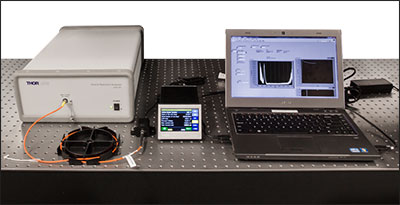
Click to Enlarge
LEDの波長と電流の関係を測定するためのセットアップ。使用した部品すべての一覧については下表をご覧ください。
| Item # | Description |
|---|---|
| - | Fiber-Coupled LED |
| - | SMA-to-FC/PC Fiber Patch Cable LEDs with Wavelengths ≤405 nm: Custom Cable with FG105ACA Solarization Resistant Fiber LEDs with Wavelengths >405 nm: M16L01 |
| DC2200 | High-Power LED Driver, 2 A Current Limit |
| - | Fourier Transform Optical Spectrum Analyzer |
LEDの駆動電流によるスペクトル変動
すべてのLEDは駆動電流の変化によりスペクトルプロファイルならびにピーク波長が変化します。当社のファイバ出力型LEDについては光スペクトラムアナライザ(OSA)を使用し、駆動電流がゼロに近い値から最大値まで増加したときの波長シフトを調査しました。
LEDの発光プロファイルは比較的広がりがあり非対称です。LEDの重心波長は、発光プロファイルにおける波長の加重平均です(質量中心の計算と似ています)。次の式で与えられます。

ここに、I(λ)は波長λ毎での強度です。よってここでは電流の変化に対するLEDの重心波長を追うことにより、ピーク波長のシフトとスペクトルプロファイル全体の変化の影響を捉えます。 OSAのPeak Trackモードでは、ユーザ設定の強度の下限値を使用して計算に必要な波長の上限ならびに下限(λ2とλ1)を求めることにより、スペクトルピークの重心波長を自動的に計算します。ここでは強度の下限値をピーク強度より6 dB下がった値に設定しました。
各LEDには高出力LEDドライバDC2200を使用し、プリセットした電流値でLEDを駆動しています。各電流値ではOSAでLEDスペクトルを5回走査し、これらを合わせて平均スペクトルを生成しました。OSAは予測されるピーク波長の50 nmの範囲内で最大の強度値を探すことでピーク波長を特定し、上記に説明した方法で重心波長を計算します。重心波長はLEDの電流リミット値まで0.05 A毎に求められました。全てのプロセスはLED毎に4回繰り返し行いました。 OSAによる計測はすべて絶対パワーならびに高分解能分光モードで実施されています(OSAの動作モードについては製品紹介ページをご覧ください)。
計測結果は下表に掲載しています。グラフのアイコンをクリックしてご覧いただけます。各LEDの重心波長は、それぞれの電流値で得られたすべての値の平均値を求め、プロットされています。すべての実験における各電流値での最小ならびに最大波長が測定され、赤いエラーバーで示されています。最小電流値ではLEDの強度が弱すぎてノイズレベルを超えず、波長を正確に測定することができませんでした。そのような影響を及ぼす電流値はグラフから省かれています。
実験の制約
- 型番毎に1つのユニットのみをテストしました。プロット図は電流毎の重心波長の一般的な変化を示すもので、出力波長の絶対値ではありません。同じ型番でもLEDにより重心波長にばらつきがでる可能性があります。
- LEDは温度制御されていません。
| Pin | Specification | Color |
|---|---|---|
| 1 | LED Anode | Brown |
| 2 | LED Cathode | White |
| 3 | EEPROM GND | Black |
| 4 | EEPROM IO | Blue |

ピン接続
右の略図には、ファイバ出力型LEDアセンブリのオス型コネクタが示されています。標準的なM8×1センサ円形コネクタです。 ピン1 と2はLEDへの接続用、ピン3と4は内蔵EEPROM(電気的消去可能ROM)用です。 当社以外のLED ドライバでは、ピン1とピン2に適切に接続し、EEPROM用ピンを介してLEDを動作させないようご注意ください。
駆動するLEDから最大の光パワーを出力させるには、LEDの最大電圧および最大電流と同等あるいはそれ以上の電圧と電流を出力できるドライバが必要です。
| Compatible Drivers | LEDD1B | UPLEDa | DC40a | DC2200a | DC4100a,b | DC4104a,b |
|---|---|---|---|---|---|---|
| Click Photos to Enlarge | 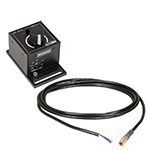 | 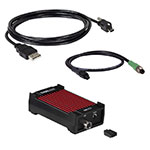 | 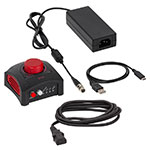 | 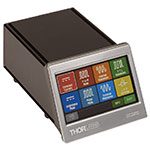 | 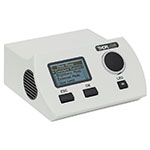 | 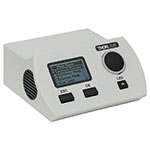 |
| LED Driver Current Output (Max)c | 1.2 A | 1.2 A | 4.0 Ad | LED1 Terminal: 10.0 A LED2 Terminal: 2.0 Ae | 1.0 A per Channel | 1.0 A per Channel |
| LED Driver Forward Voltage (Max)f | 12 V | 8 V | 14.0 Vd | 50 V | 5 V | 5 V |
| Modulation Frequency Using External Input (Max) | 5 kHzg | - | 5 kHzg | 250 kHzg,h,i,j | 100 kHzg,h,j (Simultaneous Across all Channels) | 100 kHzg,h,j (Independently Controlled Channels) |
| External Control Interface(s) | Analog (BNC) | USB 2.0 | USB 2.0, TTL, and Analog (BNC) | USB 2.0 and Analog (BNC) | USB 2.0 and Analog (BNC) | USB 2.0 and Analog (8-Pin) |
| Main Driver Features | Very Compact Footprint 60 mm x 73 mm x 104 mm (W x H x D) | USB-Controlled | Driver Current Up to 4.0 A, Manual and USB-Controlled | Touchscreen Interface with Internal and External Options for Pulsed and Modulated LED Operation | 4 Channelsb | 4 Channelsb |
| EEPROM Compatible: Reads Out LED Data for LED Settings | - | |||||
| LCD Display | - | - | - |
| Posted Comments: | |
Thibaut Moulin
(posted 2024-03-20 13:28:33.177) Hi, i have a M590F3 source. I am interested of the shift wavelength for this source. I hav read the graphic for M595F2 beacause this source is near in term of wavelenght. It seems there is a mistake with the graphic because the waveleght value do not correspond to the M595F2 source. hchow
(posted 2024-03-21 04:43:30.0) Dear Mr. Moulin, thank you for your feedback. I do see the confusion now. I have checked the test reports of the M590F3 and M595F2, and they do correspond to the peak wavelengths at 590 nm and 595 nm. I apologise for the confusion on the raw data and the spectrum graph shown on our webpage. We will get it changed ASAP. kim bumjin
(posted 2024-03-11 12:07:56.247) hello. I want to make a collimated LED light source for RGB (455, 520, 625nm - not fixed) with a beam size of less than 5mm. Can you recommend a light source and collimating optics? Suvvi K N
(posted 2023-10-27 11:53:57.63) Hi,
I recently purchased
MCWHF2, 6200K, Cold white LED from thorlabs. I only used it couple of times and the LED seems to not working now. I did pay attention to the current and was kept within the requirement mentioned in the data sheet.
I also did try to check inside this LED and I think that the metal core LED is damaged and needs to be replaced. Could you please provide some assistance as how to achieve this? Is it possible to purchase single metal core PCB LED compatible with this
MCWHF2 light source from you and replace it by ourselves?
Or do we need to ship it back to you for replacing it. The device was purchased in July 2023 for your reference.
Thanks in advance hchow
(posted 2023-11-02 09:46:51.0) Dear Suvvi K N, thank you for your enquiry. It is unfortunate that your device is not functioning as it should. I will personally reach out to you via E-mail to see how we can assist you. Thank you. user
(posted 2023-06-16 10:21:09.057) I want to buy MBB1F1,but I wonder how its power / luminance acts as time and current changes. jweimar
(posted 2023-06-22 02:10:02.0) Thank you very much for your inquiry. You can find additional information about the power/ time dependence by clicking the “Stability” tab on the product page. We will reach out to you directly to share the plots with you. user
(posted 2023-05-23 15:25:47.87) Hi Thorlabs,
I use the M1050F3 in combination with a M91L01 fiber (200 micron core). I measure only 220uW after the fiber instead of the expected 900uW. Do you see anything, I can try to improve that?
Thanks! hchow
(posted 2023-05-24 05:50:16.0) Dear User, thank you for your feedback. I am sorry to hear that you are not getting the output optical power you are expecting from our products. I will personally reach out to you to see how best to solve your problem. Thank you. 斌 赵
(posted 2023-04-14 22:26:52.843) Light source stability is too poor, can be repaired hchow
(posted 2023-04-17 09:32:50.0) Dear Mr. 斌 赵 , thank you for your feedback. I am sorry to hear that you are experiencing problems with your fiber coupled LED. But not to worry, I am here to help. I will personally reach out to you to rectify this problem. Thank you. user
(posted 2023-03-13 10:26:55.243) The axis labels for the spectrum in the spec sheet are swapped. fmortaheb
(posted 2023-03-16 11:17:08.0) Thank you very much for your feedback. We will correct it as soon as possible. Biswaranjan Behera
(posted 2023-03-09 14:27:40.49) Can this be operated using a pulser with a short pulse duration? wskopalik
(posted 2023-03-14 05:01:21.0) Thank you very much for your feedback!
These fiber-coupled LEDs can be operated in a pulsed or modulated mode as well.
I will contact you directly so we can see if your requirements can be achieved with these LEDs. Dirk Hoenig
(posted 2022-03-01 12:14:57.417) Hello Thorlabs,
the specs datasheets of the fiber coupled LEDs state: "Optical power increases proportionally with the core diameter and nearly proportionally to the square of the NA."
Why is that so instead of being proportional to the core area (thus diameter squared)?
Best regards
Dirk wskopalik
(posted 2022-03-16 09:20:03.0) Thank you very much for your feedback!
It depends on the dimensions of the LED emitter compared to the fiber core if the power increases proportional with the core diameter or proportional with the square of the core diameter, i.e. the core area. For these fiber-coupled LEDs, the emitter is in most cases larger than the used fibers so the power is usually proportional with the core area. We will check and correct the statement in the spec sheets.
Please note however that this proportionality should only be considered a rule of thumb. There may be deviations from this proportionality between different fibers due to the fiber type, OH content in the fiber, NA of the fiber, etc.
I have also contacted you directly to discuss this in more detail. M. H.
(posted 2022-02-18 02:49:06.78) Hello,
I would like to know if it is possible to run the LED's with more current if I provide enough cooling.
I would like to use one of these LEDs to create a homogeneous illumination over a Square Core fiber (150x150um). But I need a power >10mW at the fiber output at a wavelength between 450-530nm.
Thanks dpossin
(posted 2022-02-21 05:21:51.0) Dear customer,
Thank you for your feedback. We generally do not recommend to increase the current over the specified maximum as this can lead to reduced lifetime or damage. However the optical output power can be increased by using a fiber with a larger core diameter. For example the output from M780F1 has been increased by a factor of around 5 by using a 1000µm core fiber (M30L02). I am reaching out to you in order to discuss this in more detail. user
(posted 2021-08-07 01:24:01.76) Hello, I would like to know the coherence length of led source MWWHF2. Thank you YLohia
(posted 2021-08-06 04:59:53.0) Hello, thank you for contacting Thorlabs. LEDs are incoherent sources, so we cannot spec or measure a coherence length for these. user
(posted 2020-12-15 04:03:29.49) Hello, I am looking for a fiber-coupled white-light LED with more output power than the 23.1 mW of the MWWHF2. Do you have something like that? Or would it be possible to use a multi-mode fiber with a core diameter > 400 µm to increase the power further? Thanks in advance and best regards. MKiess
(posted 2020-12-15 10:39:43.0) Thank you very much for your inquiry.
If you use a fiber with a larger core diameter and a larger NA, this will lead to higher optical output powers at the fiber output. We recommend using multimode (MMF) fiber with the MWWHF2. Optical output power is specified for a Ø400 μm MMF with an NA of 0.39 at the maximum allowed LED current. Optical power increases proportionally with the core diameter and nearly proportionally to the square of the NA.
I have contacted you directly to discuss further details. Naveen Tangri
(posted 2020-10-23 16:05:09.817) Hello,
We're located in Santa Clara, California and we're looking for OEM quantities of broadband unmounted SMT LEDs for embedded applications. We looked at your LEDSW50 but its spectral power distribution curve is too "wavy gravy". However, the LED used in your MBB1F1 appears to have a flatter and more uniform spectral curve.
So here's the question...would Thorlabs be willing to sell just the LED used in your MBB1F1? We'd be open to signing some sort of "non-compete" agreement, if required.
Sorry for the oddball question, and "no" would be a perfectly acceptable response, but we wanted to know either way.
Thanks and best regards! MKiess
(posted 2020-10-27 07:01:49.0) Dear Naveen, thank you very much for your inquiry. The right LED for your application in this case is probably the MBB1D1. This broadband LED ranging from 470nm to 850nm and has a relatively flat spectral emission over this wavelength range. Furthermore, this is the pure LED on a metal core PCB.
I have contacted you directly to discuss further details. John Keech
(posted 2019-11-20 16:36:43.507) What is the laser safety rating of LED fiber coupled sources? Are they safety rated in this way?
https://www.thorlabs.com/newgrouppage9.cfm?objectgroup_ID=5206
Thank you,
John Keech
Corning Inc. MKiess
(posted 2019-11-22 10:32:04.0) This is a response from Michael at Thorlabs. Thank you very much for the inquiry. These LEDs are classified in risk groups according to the International Standard "Photobiological Safety of Lamps and Lamp Systems" IEC 62471. This is different depending on the desired LED. The exact risk group of the individual LEDs can be found in the LED specification sheet, which can be downloaded on our webpage, in the Warnings and Safety section. marcin.bartosik
(posted 2018-08-10 14:08:50.093) Hello!
Could you please let me know if the MCWHF2 can be powered by a 12V DC from a 280W power supply?
Have a nice day,
Marcin swick
(posted 2018-08-13 05:12:19.0) This is a response from Sebastian at Thorlabs. Thank you for the inquiry.
Basically it is possible to drive our LEDs with constant voltage sources.
In order to drive the MCWHF2 with a constant voltage you need to limit the current to 1 Ampere. I contacted you directly to provide further assistance. edwin.walker.ctr
(posted 2017-10-11 19:52:36.64) using the M780F2 780 nm, 5.5 mW (Min) Fiber-Coupled LED, with LEDD1Ba driver, what is the output power stability %rms? is it 5%rms variation or 10%rms output power variation wskopalik
(posted 2017-10-19 10:03:13.0) This is a response from Wolfgang at Thorlabs. Thank you very much for your inquiry.
The driver LEDD1B is specified with a current ripple of 8mA. This ripple could also be seen in the light emission of the LED. The M780F2 has a max current of 800mA so this would correspond to 1% variation.
The LED itself will show a decrease in power during operation which would depend e.g. on the current and on the ambient temperature. This decrease is typically in the range of 3-5%. When the LED is switched on, there might also be some short term overshoots due to the driver or due to temperature changes. Other variations are not expected.
I will contact you directly to talk about your requirements in more detail. fmor82
(posted 2015-11-25 16:38:00.073) To Whom It May Concern:
I am writing to ask you something about the cable used to power the LED (M385FP1).
I would like to know how many wires you have inside this cable.
Thank you in advance,
Flavio Mor. shallwig
(posted 2015-11-26 03:58:45.0) This is a response from Stefan at Thorlabs. Thank you very much for your inquiry. There are 4 wires inside the cable of our fiber coupled LEDs. In the “Pin Diagram” tab on the website you can find the pin assignment information : http://www.thorlabs.com/newgrouppage9.cfm?objectgroup_id=5206&pn=M385FP1#5262
The connector we use is a standard M8 x 1 sensor circular connector. I will contact you directly to check if you have any further questions. user
(posted 2015-09-01 15:52:41.237) Yes, I understand that now the fiber which you use is 200 um and 0.22NA. The thing which I don't understand is that the coupled light is the same that with the other of 0.39NA. It is supposed that it would be less the coupled light with 0.22NA than 0.39NA, but you haven't change any value, so I'm a bit confused. I thought that with 0.22NA the coupled light will be 3.14 times less than with 0.39NA.
William shallwig
(posted 2015-09-02 02:11:40.0) This is a response from Stefan at Thorlabs. Thank you again for your inquiry. The values from the website did not change since we never measured them with a 0.39NA fiber, they were always measured with a 200 µm core 0.22NA fiber. 0.39NA was a typo in the specs which we revised. Maybe we can discuss this by email. Since you left no contact data, could you please contact me at europe@thorlabs.com. Thank you. user
(posted 2015-09-01 13:32:41.34) Hello,
Last month I started to see Thorlabs light sources, and to see their technical characteristics to make a purchasment for my univerity laboratory.
Today, I come back from holidays, and I see that some changes have taken place, you have change the fiber characteristics for fiber coupled light power.
Last month, they were a fiber of 400 um and 0.39 NA and other of 200 um and 0.39 NA, but today the 200 um fiber has 0.22NA.
I'm surprised that the light coupled power values doen't change in any case because I thought that it depends of fiber characteristics.
Since I know, the coupled light must be 3 times less in 0.22NA case compared with 0.39NA case.
William shallwig
(posted 2015-09-01 09:01:41.0) This is a response from Stefan at Thorlabs. Thank you very much for your inquiry. The power values were always tested with a 200µm 0.22NA fiber (FG200UCC). The numerical aperture NA 0.39 was a typo which we removed. casey.donaher
(posted 2015-07-15 15:13:09.613) Just noticed that the spec sheet for M617F1 says max 1000mA, but the DC2100 sets its max to 700mA when the M617F1 is plugged into it.
One or the other is wrong. One the plus side, the other is right (maybe.) shallwig
(posted 2015-07-16 07:01:23.0) This is a response from Stefan at Thorlabs. Thank you very much for your inquiry. The maximum current which can be applied to this LED is as stated in the spec sheet 1000mA. In the manual of the DC2100 on page 14 http://www.thorlabs.com/thorcat/18300/DC2100-Manual.pdf it is described how the user Limit current can be changed. I guess you could not change this current to 1000mA for your M617F1. In this case there is most likely a wrong value written to the LEDs EPROM. I will contact you directly to troubleshoot this in more detail. cilveti.ander.92
(posted 2015-03-19 16:51:17.157) Hi, I was looking the M420F2 coupled light source to purchase it, because his great coupled power, 8.9 mW in 200um fiber. But then I read the datasheet, and I look that there puts that the minimun power coupled in a 400um fiber is also 8.9 mW... It is also strange that in others light sources usully the power coupled in 400un core fiber is 4 times bigger than in 200um(for example M365F1 200um:1mW and 400um:4.1 mW), but in 420nm case is less than 2(200um:8.9mW and 400um:16.2 mW).
So the question is, is really that the power coupled in 200um fiber is 8.9 mW??or is another value?? shallwig
(posted 2015-03-20 06:54:48.0) This is a response from Stefan at Thorlabs. Thank you very much for your inquiry. The specifications as stated on the website for these LEDs were measured and are correct so far. The assumption by increasing the core diameter and NA to increase the power proportionally does not take into account that each LED type has a different size and viewing angle (directional characteristic) which also influence the coupling efficiency.
All the numbers we provide on the web and in the datasheets are based on real measurements. We always treat the measurements quite conservative which means that we reduce the results typically by 10%. We measure up to 5 different LEDs with 5 different patch cords. Then we take the average and the minimum value and reduce it by 10% for our specs. By accident for this specific LED the minimum power with a 400µm fiber is nearly the same as the typical output power with a 200µm fiber.
The typical output power you can expect with a 200µm fiber is indeed 8.91mW. I will contact you directly to check if you need any further information. andisetiono
(posted 2015-02-25 03:13:43.507) I want to know, Is power cable included to the product? thank you tschalk
(posted 2015-02-25 07:22:06.0) This is a response from Thomas at Thorlabs. Thank you very much for your inquiry. The power cable is attached to the fiber coupled LED. Please note that you need an additional LED controller to drive the unit. Therefore you can use a DC2100 or a LEDD1B. user
(posted 2014-02-03 17:09:20.777) Hello, are these continuous wave sources? tschalk
(posted 2014-02-04 02:25:49.0) This is a response from Thomas at Thorlabs. Thank you very much for your inquiry. These LEDs are compatible with our LED drivers LEDD1B, DC2100 and DC4100 which can be found here: https://www.thorlabs.com/navigation.cfm?guide_id=2109. With all drivers the LEDs can be used as a continuous wave source. It is also possible to use the modulation input of each driver and to use the LEDs as a pulsed source. The DC2100 provides also Pulse Width Modulation Mode which can be used without an external Modulation source. Please contact me at europe@thorlabs.com if you have any further questions. kcs32
(posted 2013-12-19 11:42:49.89) Hello,
I'm curious about the long power/EEPROM cable shown on the back of the fiber coupled LED. Is this cable permanently attached to the back of the device, or can it be removed? This is not obvious from the pictures and drawings I've seen.
Can to CON8ML-4 mating connector be plugged directly into the device instead of at the end of this cable? I'm thinking of using these LED's in a small volume, portable device, so minimizing the space taken up by the long cable would be very helpful. Thank you tschalk
(posted 2013-12-20 08:49:48.0) This is a response from Thomas at Thorlabs. Thank you very much for your inquiry. The cable is permanently attached to the LED so it can not be replaced by the CON8ML-4. We can offer you a device with a shorter cable and i will contact directly with more detailed information. carlos.paladini
(posted 2013-11-21 19:31:52.507) It seems that the M625F1 has a peak intensity actually at about 635 nm and the M617F1 has a peak at about 625 nm on the spectrum pop-up window. Is this correct? I would like an LED with peak intensity at 625 nm but am confused by the name of the LED and its stated peak light intensity. In other words, which LED actually delivers peak light intensity at 625 nm, the M617F1 or the M625F1?
Thanks tschalk
(posted 2013-11-25 06:47:50.0) This is a response from Thomas at Thorlabs. Thank you very much for your inquiry. For our visible LEDs the so called "dominant wavelength" is given and this specification takes the sensitivity of the human eye into account. The spectra provided on our homepage are correct and if you need a peak wavelength of 625nm the M617F1 would be the right choice. joerg.koenig
(posted 2013-10-10 19:53:13.937) Hi, what is the spectral power density [W/nm] of the MWWHF1 using a 400 µm core fiber? tschalk
(posted 2013-10-15 05:10:00.0) This is a response from Thomas at Thorlabs. Thank you very much for your inquiry. Unfortunately we can not provide the spectral power density of this light source. It is also depending on which fiber you are using. I will contact you directly to discuss your application. jlow
(posted 2012-09-26 09:52:00.0) Response from Jeremy at Thorlabs: The 5.1mW is the typical output power when using a Ø400µm core fiber with 0.39 NA with 1000mA drive current. When a larger core fiber such as the M35L0x (Ø1000µm, 0.39NA) is used, the coupling efficiency from the LED to the fiber is increased, hence the 17.61mW min. power. tpth
(posted 2012-09-26 09:27:45.0) Dear Sir:
I have a question:
Why the mininmum power 17.61mW (in a table)can be obtained when you use 530nm LED with a fiber M35L0x, though input power is 5.1mW?
I need a precise estimation of the amount of decrease in LED power during propagating in a fiber.
Please let me know the correct answer before my order.
Best regards.
Tsutomu Hoshimiya,
Prof. Tohoku Gakuin University jvigroux
(posted 2012-06-06 11:13:00.0) A response from Julien at Thorlabs: Thank you for your inquiry! There will always be a trade-off to be found between fiber diameter and/or NA (ie. beam quality) and optical power coupled into the fiber. When using a fiber having a NA of 0.39, the focal length for the collimation lens to be used should be about 1mm. The beam quality that would however result from the combined effect of such a short focal length and the fiber diameter would lead to quite high divergence. In you case, I would recommend using a somewhat longer focal length for the collimation lens and subsequently a beam expander for the beam diameter reduction. I will contact you to discuss further the exact requirements of your setup to find what the most suited solution would be. igkiou
(posted 2012-06-06 04:37:26.0) Hi, I am interested in creating a very collimated white beam of diameter < 0.8 mm. MCWHF1 provides enough output power when used with the fiber you used for your tests, a MM 400 um 0.39 NA fiber. What would you recommend using for collimation of the output of this combination? Would you recommend any of your prepackaged collimators? Thank you in advance for your assistance. tcohen
(posted 2012-05-14 09:18:00.0) Response from Tim at Thorlabs: Thank you for your interest in our products. Our sales department will contact you to provide you with an official quote. emlee1
(posted 2012-05-13 12:32:44.0) I am interested to purchase this product. Can you email me the quotation for this product and a suitable power supply for use in Singapore? Do include shipping to Singapore as well in your quote. Thanks. jvigroux
(posted 2012-02-06 13:00:00.0) A response from Julien at Thorlabs: thank you for your inquiry! Unfortunately, as of now, there is no LED available with a high enough power in the wavelength range. I will ocntact you to know your exact requirement sin order to see which alternative there could be. kforsyth
(posted 2012-02-06 11:37:11.0) Any plans for going shorter in wavelength soon, say to 250 - 300 nm? jvigroux
(posted 2011-12-15 10:17:00.0) A response from Julien at Thorlabs: I just measured the coupled power in a 460HP fiber from a MCWHF1. The output power out of the fiber was around 50nW. In comparison, a 400µm 0.39NA fiber would yield an output power of around 7mW. jvigroux
(posted 2011-12-14 11:52:00.0) A response from Julien at Thorlabs: thank you for your inquiry! We do not have the value yet but I will perform the measurement by tomorrow and let you know the obtained value. doerr
(posted 2011-12-14 17:22:01.0) Hi,
I need a white light source coupled to a single-mode fiber. I've tried with regular halogen bulbs, but the output power is at least 10 times to low. The white light LED would be an option, even though the spectral distribution is not optimal. Can you give me any numbers what coupling efficiency or output power I can expect from a LED coupled to a single-mode fiber? Fiber type would be the same as with the 460HP patch cords. jvigroux
(posted 2011-08-29 12:21:00.0) A response from Julien at Thorlabs: thank you for your feedback. We are in the process of measuring the power coupled into different standard fibers using the fiber coupled LEDs. Before publishing those values however, the tests have to be ran until the end and critically assessed. I will contact you directly per email in order to discuss with you the values that can be expected for your configuration. rhs
(posted 2011-08-22 12:50:51.0) I miss some guidelines for choosing the optimal delivery fiber. Your measurement data has been obtained using a 400µm/0.4NA MM fiber, but that doesnt say much about the performance when using a different fiber.
It would be extremely helpful to have just two graphs showing the spatial distribution and the angular distribution of intensity at the coupling plane.
Thank you. jjurado
(posted 2011-08-05 09:30:00.0) Response from Javier at Thorlabs to last poster: Thank you very much for your feedback!The mounts for these fiber-coupled LEDs have been designed to accept for M6 and 1/4" diameter screws. We will take a look at our current units to make sure that both screws fit and will make changes if it turns out that 1/4" screws are not compatible. Regarding the marking of the center wavelength, there is actually an identification label on the back side of the device with the part number of the LED, which calls out the center wavelength (with the exception of the MCWHF1 cold white LED). Please contact us at techsupport@thorlabs.com if you have any further questions or comments. user
(posted 2011-08-02 18:32:35.0) The mounting slots are designed for M6 screws and dont pass 1/4" screws that are used in the USA.
It would also be nice to have the center wavelength engraved on the housing, either on the front surface, or on the top edge. |
こちらのページでは当社が販売するすべてのLEDをご覧いただけます。More [+]をクリックすると、下の各LED製品の波長をご覧いただけます。
| Light Emitting Diode (LED) Selection Guide | ||||||
|---|---|---|---|---|---|---|
| Click Photo to Enlarge (Representative; Not to Scale) |  |  |  |  |  |  |
| Type | Unmounted LEDs | Pigtailed LEDs | LEDs in SMT Packages | LED Arrays | LED Ring Light | Cage-Compatible Diffuse Backlight LED |
| Light Emitting Diode (LED) Selection Guide | ||||||
|---|---|---|---|---|---|---|
| Click Photo to Enlarge (Representative; Not to Scale) |  |  |  |  |  |  |
| Type | PCB- Mounted LEDs | Heatsink- Mounted LEDs | Collimated LEDs for Microscopyb | Fiber- Coupled LEDsc | High-Power LEDs for Microscopy | Multi-Wavelength LED Source Optionsd |

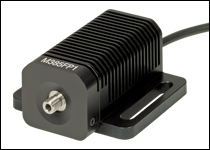
Click to Enlarge
M365FP1、M385FP1、M395FP1、M405FP1、M660FP1は、長さ50 mmのヒートシンクにマウントされています。
- LED の自動設定用 EEPROM内蔵(当社コントローラに対応)
- >10 000時間の長寿命(M280F5、M325F4、M340F4、M660FP1を除く。詳細は「仕様」タブ参照)
- 出力は対応するコントローラで変調可能(詳細は「LEDドライバ」タブ参照)
- 温度管理が最適化されており安定した光強度
- SMAファイバーコネクタ
このファイバ出力型LEDは、SMAコネクタ用のバルクヘッド付きヒートシンクに取り付けられています。当社の SMAコネクタ付きマルチモードファイバーパッチケーブルを使って、光学系に容易に組み込むことが可能です。パッチケーブルがLED筐体のSMAバルクヘッドに接続されると、LEDはSMAファイバーコネクタと突合せ結合する形になります。ハイブリッドパッチケーブルを使用してSMAコネクタからFC/PCコネクタ、フェルール、 ファイバ素線への変換も可能です。お使いいただけるLEDドライバについては、「LEDドライバ」タブをご参照ください。尚、下の製品名に掲載されている最小出力パワーは、LEDをコア径Ø400 µmのマルチモードファイバーパッチケーブルと使用した場合の値です。
こちらのファイバ出力型LEDはFC/PCコネクタ用バルクヘッドでの構成も可能です。詳細は当社までお問い合わせください。

- 4ピンメスPico型(M8)レセプタクル
- マウント付きLEDの電源ケーブル接続用M8 x 1ネジ
- パネル取付け用M8 x 0.5ネジ、カスタム筐体用
- 長さ0.5 mのAWG24ケーブル
- IP 67およびNEMA 6P規格準拠
コネクタCON8ML-4をご使用いただくことで、お手持ちの電源を当社のマウント付きLEDに接続することができます。当社では4ピンオス型M8接続ケーブル(型番CAB-LEDD1)もご用意しております。
| Pin | Color | Specification | 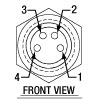 |
|---|---|---|---|
| 1 | Brown | LED Anode | |
| 2 | White | LED Cathode | |
| 3 | Black | EEPROM GND | |
| 4 | Blue | EEPROM IO |

マウント付きLEDの4ピンM8プラグに接続しているCON8ML-4
 Products Home
Products Home


















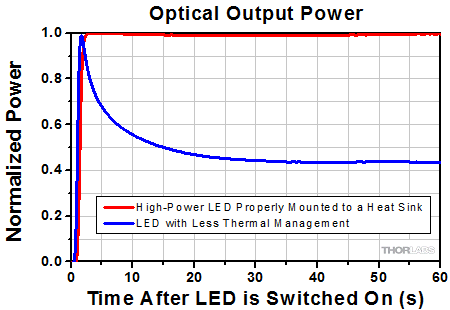
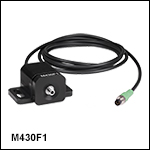
 ズーム
ズーム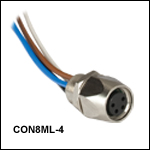
 ファイバ出力LED
ファイバ出力LED